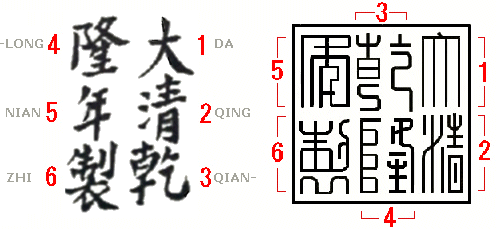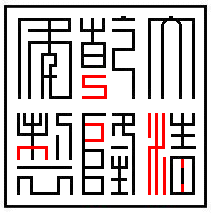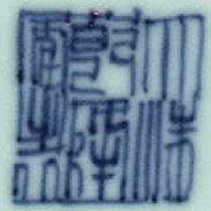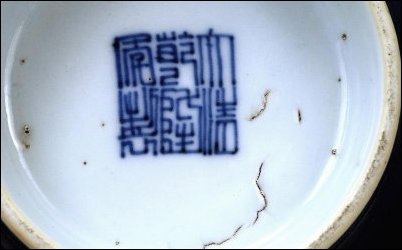|
Seal Marks & Experts Inconsistencies in both. Since adding the Calligraphy link to my site, I've received a few nice comments. Though the info I provide is very basic, the comments tell me that many are interested in the subject. Since seal marks are based on calligraphy, I thought it might be a good idea to give an example of the connection. I could easily scramble around the Internet and collect hundreds of images, then say "Here they are...". But my intention is to help you understand better what you are looking at, not just provide a million images. It really does help in collecting if you have either a basic knowledge of Chinese calligraphy, or at least some good reference materials. Though I prefer the Wade-Giles transliteration, I am using Pinyin for this discussion. The simplified and traditional Chinese converters I've tested are not entirely perfected, so my Chinese readers have to overlook (and forgive) any inconsistencies. I've put together a very simple page that allows you to view any Qing dynasty reign's associated seal mark. You can click on a thumbnail and view a full screen image by visiting the link below. You will soon realize that there are many different versions (or styles) used. The additional info I'm providing here is tied in with a few questions I've had over the years regarding a seal mark on one of my pieces. A few students noticed that my green Qianlong bowl is different in one area when comparing its mark with other published seal marks for the Qianlong reign. Though I explained the best I could to those that inquired, I always felt the explanation was lacking in depth. Adding this extra page to my site will address that question and, at the same time, introduce the link between calligraphy and seal marks. This will also point out that the 'experts' at the top level quite often haven't a clue. I'll tie this in with a conversation I had with the head of the Chinese Ceramics Department of one of the world's major auction houses a few years back. No name given out of professional courtesy. I would suspect however, that he bares a strong resemblance to this person. Here's the incident. In viewing my bowl, he immediately remarked that it was fake because the seal mark was wrong, it had 2 mistakes. Though I was already aware of the differences in the mark, I decided to further probe the depth of his knowledge. I was genuine in doing so, thinking perhaps he knew something I didn't. To the best of my recollection, here's how the conversation went. The red font is the 'experts' dialog. My questions are in blue. . "Fake ...... what's wrong with the mark?" "It's
got a
backward five ( "Can you read Chinese?" "Yes" ..... "Can you write Chinese?" "No, but I don't need to in order to recognize a fake." "Can
you tell me
what the . At this point the 'expert' became rather upset. I don't remember the exact response, but it was to the nature of his being too busy and important to give me a class on Chinese calligraphy. The conversation ended rather abruptly. I was sorry, I was really having fun. His answer of "Yes" to my question of "Can you read Chinese?" was incorrect. He could only recognize the mark, not read it. There is a big difference. So now I'll show you the mark, show you the differences, and explain the reason for the differences. But first, a little info on seal marks. The seal mark (or seal script) goes back as far as the Shang dynasty, possibly earlier. Oracle bones may have given the first sign, but the interpretation does not set the standard. They have been used on almost every type material, stone, bronze, porcelain, pottery, wood, ivory, etc. They are either carved (incised or raised), inlaid (using various materials), stamped, or painted. They are also sometimes referred to as Temple marks. They became fairly standard for the Qing dynasty, not quite so standard for the Ming dynasty. The exactness of the mark for any specific period can vary. Though most appear identical (uniform) for the specific reign they represent, close inspection will reveal many subtle differences. Unlike calligraphy, seal marks often reflect the artists rendition. This individuality can sometimes be helpful in matching certain marks to other pieces marked by the same hand (artist) within the period. The same can be applied to the calligraphic style of marks as well, but the latter falls more in the area of handwriting analysis. Since Chinese calligraphy often has more than one character to represent one specific thing, the character best suited for application in seal form was chosen. Further down in the study I'll give some examples. The subject mark for this discussion is for the Qing emperor Qianlong (1736 - 1795). The standard calligraphy mark is shown in Figure 1, the seal mark is shown in Figure 2. Figure 1 Figure 2 Calligraphic . Seal form Seal marks are almost always arranged in three columns of two rows. Occasionally just two columns if the dynasty call-out is omitted. Read from top to bottom, right to left, the mark in question reads Da Qing Qianlong Nian Zhi or Great Qing Qianlong Year Made. Below, for side by side comparison, shows both the seal mark and the actual subject mark for this discussion.
The
areas where the actual mark differs from the standard mark are shown in
red. There is the
noticeable Though the illustrated seal mark shown above is about as correct as they come, if you closely examine several different seal marks for this reign, you will discover that there are many subtle differences. For the 'expert' to quickly dismiss the bowl as being fake, tells me that many people are being told what they have is worthless, when indeed it may be a treasure worth many thousands of dollars. The fakers of today strive for perfection, producing flawless pieces that would mirror what you might see in the major auction house catalogs. They are catering to the likes of our 'expert', making it easy for him. What they are saying is: "Here's a perfect and beautiful piece that is conveniently too small for TL testing, yet it will bring a high price (high commission)". No faker would produce a piece with numerous visible inconsistencies in the seal mark, knowing it would raise eyebrows and suspicion. Here's where having some knowledge of Chinese calligraphy can pay off. Let's start with the . A portion of the character Qian in the forming of Qianlong
. Now we'll examine the little box that our 'expert' said was missing. This is the left most part of the character 'long' in the chosen era name of the Qianlong reign. This is an easy one since the little box he refered to is from a very fundamental character, in fact it's the 170th Radical, or Fu, which means declivity, or downward succession. Like Qian, it also signifies that which descends from heaven. Not in the way of the sun breaking through to provide abundant crops, but in the way of gifts, in this case prosperity. Guess what, there is a derivative of the 170th Radical, it's called Diu and means a lesser declivity, only 2 steps down instead of 3. Below shows both characters. Fu (figure 5), and Diu (Figure 6), the latter being used on my bowl. The use of Diu versus Fu could be interpreted as a closer connection with heaven. Only 2 steps versus 3. . A portion of the seal character 'long' in the forming of Qianlong
. Last but not least are the broken vertical lines just to the right. Though our 'expert' missed this difference, I'll still explain them since they also are different on the subject mark in this discussion. This is part of the character Qing (for the dynasty) that refers to water. In this case large water. The calligraphic mark for Qing always includes the character Shui (Figure 8), but the seal mark is based loosely on the more applicable versions of the calligraphic characters that also apply. Another Shui, (Figure 9) the 85th Radical meaning river or flowing water, Juan (Figure 10) meaning a small water course or rivulet, Guai (Figure 11) meaning a bit larger water course, and Quan (Figure 12) which means a very large water course formed by the joining of several rivers. Quan is the 47th Radical. The latter being used in seal form on my bowl. .
. The figures below illustrate how the calligraphers arrived at what became the standard seal form for the portion of the character that represents water in the dynasty mark for Qing. .
. The seal mark (Version 2) on the bowl in question was placed by and old hand for sure. Our 'expert' missed the boat. Though the incident happened many years ago, I had a chat with him recently. Though he headed the department for many years, he is now no longer with that auction house. He did not recognize my name, nor did he have any recollection of our prior conversation many years ago. I did not remind him. I'm afraid to say that he has not improved either, still making the same quick judgments that lead to incorrect conclusions. It makes you wonder how many priceless treasures have been lost to the likes of the 'experts'. I've encountered this, and even worse, at each of the world's major auction houses. My preference is to always deal with someone of Chinese descent. It always surprises me when someone of other than Chinese descent is in charge of any Chinese Ceramics Department. Perhaps a Chinese person would know too much, slowing up the primary objective of the auction house, which is of course profit. An honest, and truly knowledgeable Chinese person in this category would probably give them little to work with. Over the years I've seen
about 7 or
8 of the backward Well that about covers it. I hope the info provided is helpful. .JP Back to Main Page (menu) |













